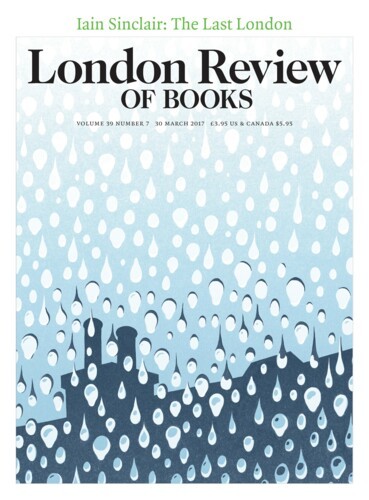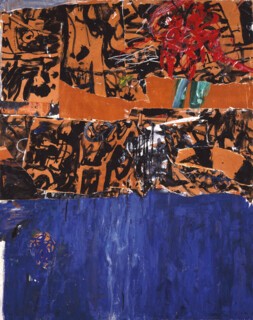‘Should the street be considered one of the fine arts?’ Fernand Léger asked in 1928. He was thinking of the objects displayed in Parisian shop windows. Others have been more impressed by junk, debris and things abandoned. The street as both source and inspiration is everywhere apparent in the exhibition at New York University’s Grey Art Gallery (until 1 April), Inventing Downtown: Artist-Run Galleries in New York City, 1952-65, in particular the grungy byways of a Lower Manhattan not yet gentrified as SoHo or rebranded as the East Village.
The gallery is packed with work, the most exciting of it raw, rude and abrasive. The sculptor George Segal made a career out of positioning life-size white plaster figures in furnished tableaux, so it’s a jolt to encounter one of his early works here, Reclining Woman Bas Relief: Nude (1958), a drippy hank of white plaster flung on a wooden plank which, hung on the wall, looks like an inexplicable object found in the trash. Aldo Tambellini’s Untitled (1961) is a chunk of concrete fixed to a wooden block, a bit of construction-site detritus that would seem dangerous even without the spikes and nails the artist has jammed into its crevices. Tambellini, who then lived on the far East Side amid entire blocks being cleared for public housing, also made gorgeous black and white slides, suggestive of imagined galaxies, which he projected on the exterior walls of condemned tenements for the pleasure of a few friendly artists and his Puerto Rican neighbours.
At once melancholy and exhilarating, Inventing Downtown evokes a lost New York City and the small, quasi-underground art world that operated between the ascension of Abstract Expressionism and the triumph of Pop – the period bracketed, say, by Life’s January 1951 photograph of the 15 ‘irascible’ New York painters (Pollock, De Kooning, Rothko et al) who’d made the news by issuing an open letter denouncing the Metropolitan Museum’s show American Painting Today, 1950, and Andy Warhol’s Get Smart cover for TV Guide in March 1966. Unable to place their work in established uptown galleries, the young, mainly abstract artists of Lower Manhattan banded together to set up co-operative exhibition spaces, sometimes doubling as coffeehouses, in empty stores on and around East 10th Street. Bounded to the west by Fourth Avenue’s used bookshops and to the east by skid row, 10th Street was in a poor East European-Jewish-Puerto Rican neighbourhood. Until the mid-1950s it was shadowed by the clattering Third Avenue El, and was home to two pawnshops, a basement pool room, a liquor store catering to winos and an employment agency that offered them temporary jobs. There ‘the ancient relation between art and the anti-social has attained a curious evolution. Instead of hoodlums – bums,’ the critic Harold Rosenberg, who lived on 10th Street, wrote in 1959 in ‘10th Street: A Geography of Modern Art’. Rosenberg’s 10th Street was a ‘trading post of ideas and of the latest moves in art’, the whole scene representing the ‘insistence of individuals on being artists’.
Like the jazz men who, ten years earlier and a hundred blocks uptown, invented bebop in jam sessions at Harlem clubs like Minton’s and Clark Monroe’s, the 10th Street artists were making art that was intended to impress other artists, not to seduce collectors. (Jazz was part of the downtown scene as well. The Five Spot Café, an artists’ hangout just off the Bowery, opened with Cecil Taylor, gave Thelonious Monk his first extended gig, and introduced New York to Ornette Coleman.) Many of the pieces in Inventing Downtown are proudly uncommercial. The exhibition includes work by a number of black and women painters, many of whom dropped out or were written out of art-world history. Renée Rubin’s rambunctious collage Coney Island Pinball (1958) and Martha Edelheit’s ‘extension painting’ Frabjous Day (1959) resist rectangular framing and all but tumble off the wall. Was their work unsellable? The two pieces appear at the Grey Art Gallery courtesy of the artists.
Inventing Downtown reverberates with the sense of artists looking at and talking to one another. The Doom Show at the March Gallery in 1961, a group exhibit held at a moment of acute Cold War anxiety in a 10th Street tenement basement that resembled a bomb shelter, drew on the chaotic theatre pieces or ‘happenings’ that young artists like Claes Oldenburg and Jim Dine had been staging in cramped spaces on the Lower East Side. The show contained Sam Goodman’s mashed toy assemblages and his buddy Boris Lurie’s collages – scabrous juxtapositions of atom bombs, magazine ads and cheesy bondage photos. Goodman’s poster for the Doom Show, which may have been the best thing in it, is at the Grey Art Gallery, spray-painted on a crumpled, fire-damaged edition of a daily newspaper. Lurie, a Latvian Jew and concentration camp survivor, made what he described as ‘no! art’. It has scarcely lost its power to offend: one piece from 1961, a photograph of a wooden platform piled high with contorted corpses, is called Flatcar, Assemblage, 1945, by Adolf Hitler. A review in the Village Voice of a Lurie show in 1960 included, Benjamin Buchloh noted years later, ‘an astonishingly complete and detailed account of the images that Warhol subsequently chose as the key figures of his iconography’.
The hallmark of the work displayed at the Grey Art Gallery is outsized ambition channelled through modest means. There are some dramatic abstractions, such as Allan Kaprow’s calligraphic ‘action collage’ Blue Blue Blue (1956), made before Kaprow swerved into happenings, and Yayoi Kusama’s No Red A (1960), a painting that gives the appearance of a lace curtain draped over a crimson field or, alternatively, of fistfuls of white pebbles dropped in a sea of roiling red. Kusama, who arrived from Japan and became an early art star thanks to a one-woman show at a co-op gallery, later turned to performance too, orchestrating some of the trippiest extravaganzas and, next to Warhol, the most impressive publicity of the late 1960s.
More often, though, smaller is better. The scorched, painted metal of John Chamberlain’s tiny Untitled (Light Bulb) from 1958 is a reproach to his later, grandiose crumpled car chassis. Many pieces are tchotchkes or small paintings, harder to associate with vast, unfinished lofts than with cramped Lower East Side apartments with bathtubs in their kitchens. These works would have been more at home in storefront galleries than white-box showcases. Oldenburg’s Store, a rented space on East 2nd Street, sold sloppily painted, plaster simulations of foodstuffs and other items.
By contrast, the great Downtown Gesamtkunstwerk was created in early 1960 in the basement of the progressive Judson Church in Greenwich Village. Working together, Oldenburg and Dine assembled what was advertised in the Village Voice as a ‘huge living construction’. Built of bundled egg boxes and other rubbish, with burned cardboard signage, crude cut-out figures and strips of newspaper hanging from naked lightbulbs, the assemblage provided a thieves-market environment for their performances. The installation of the piece was itself a performance, open to the public during normal gallery hours. Variously known as Ray Gun Show, The Street and The House, it exists now only in a few photos and murky underground films, and in the fading memories of those who were there.
In a literal come-down from the ephemeral grandeur of the Judson Church installation, the Grey Art Gallery’s lower level is given over to work associated with the Green Gallery, opened by the canny impresario Richard Bellamy on 57th Street in 1960. Its purpose was to bring downtown uptown. There are tasteful colour abstractions, elegant fluorescent light sculptures, polished minimalism and air-brushed Pop. The quintessential piece is a spiffy Tom Wesselmann assemblage, Interior #2 (1964), which includes a motorised fan, a working light fixture, a radio, a clock and a bottle of 7-Up. Everything has been painted a handsome shade of silver. Unlike a good deal of the stuff upstairs, it looks like Art.
Send Letters To:
The Editor
London Review of Books,
28 Little Russell Street
London, WC1A 2HN
letters@lrb.co.uk
Please include name, address, and a telephone number.


